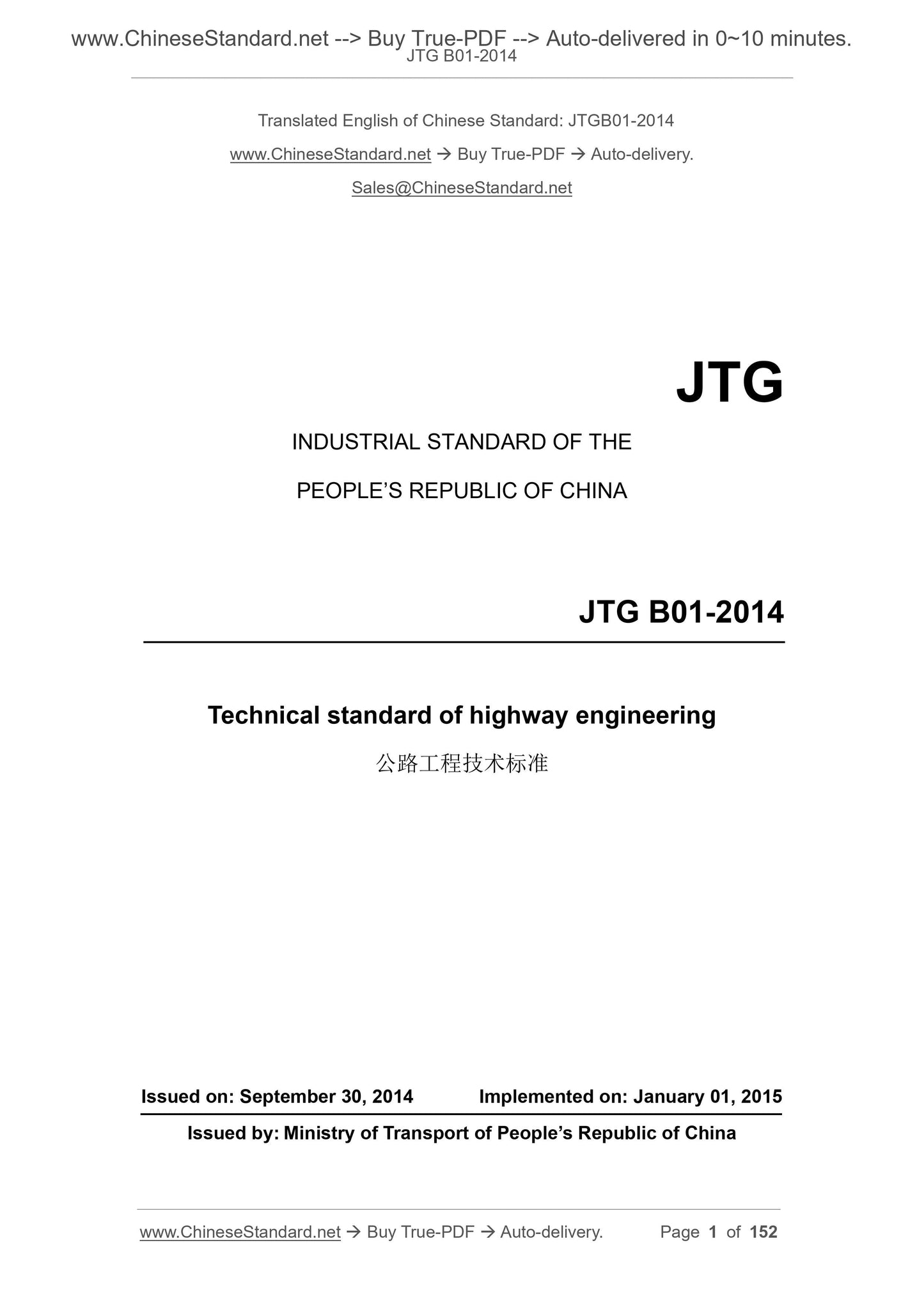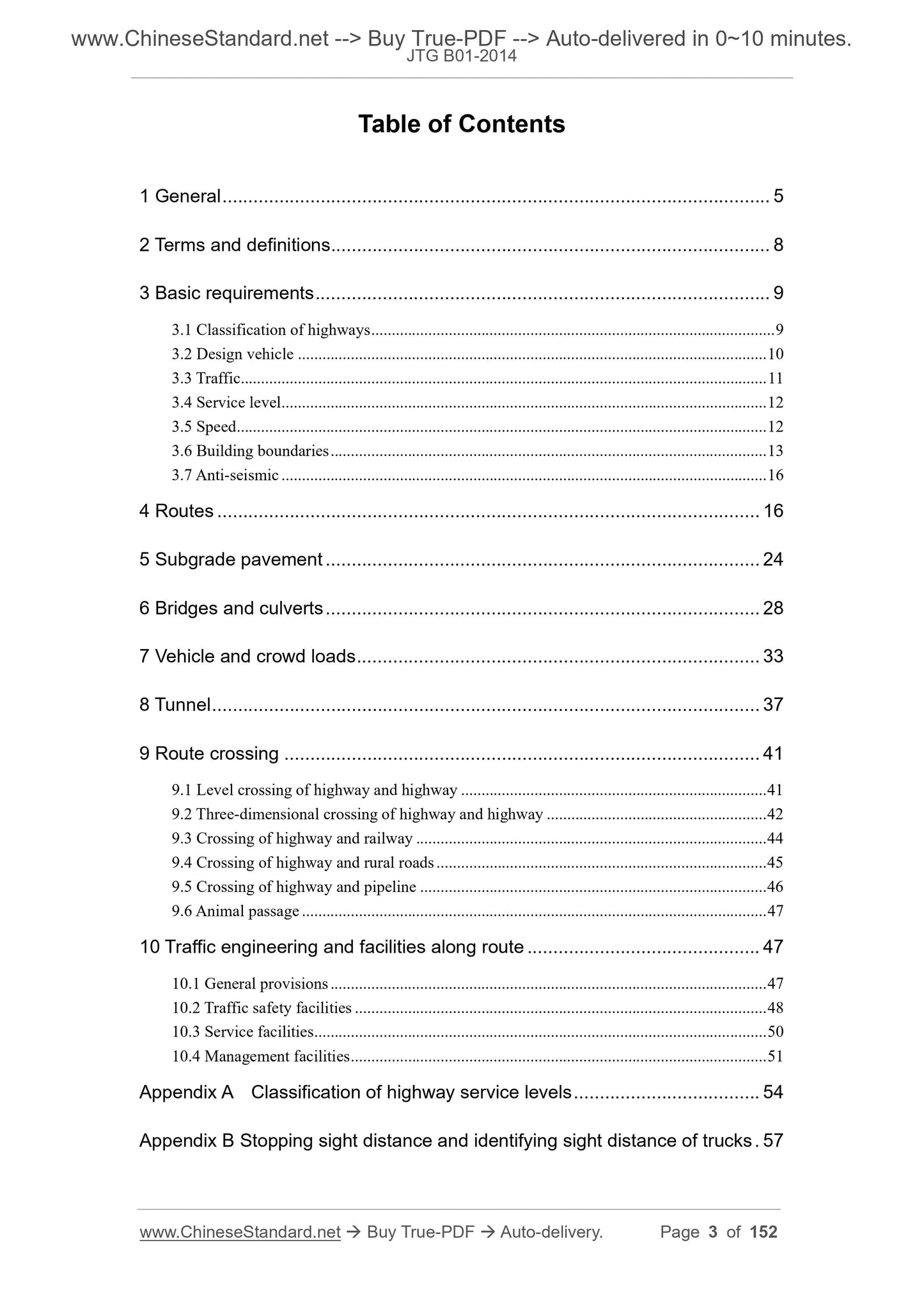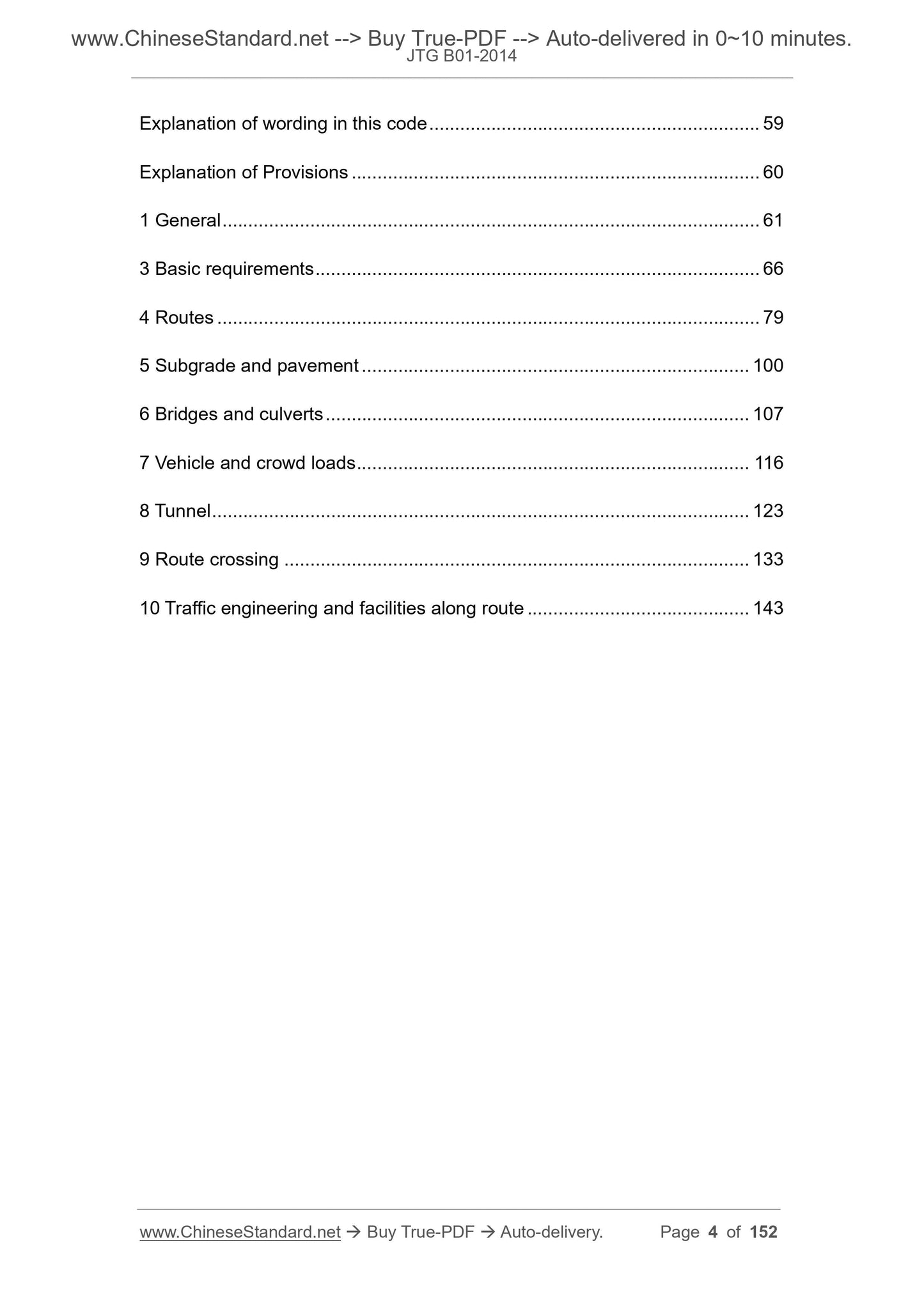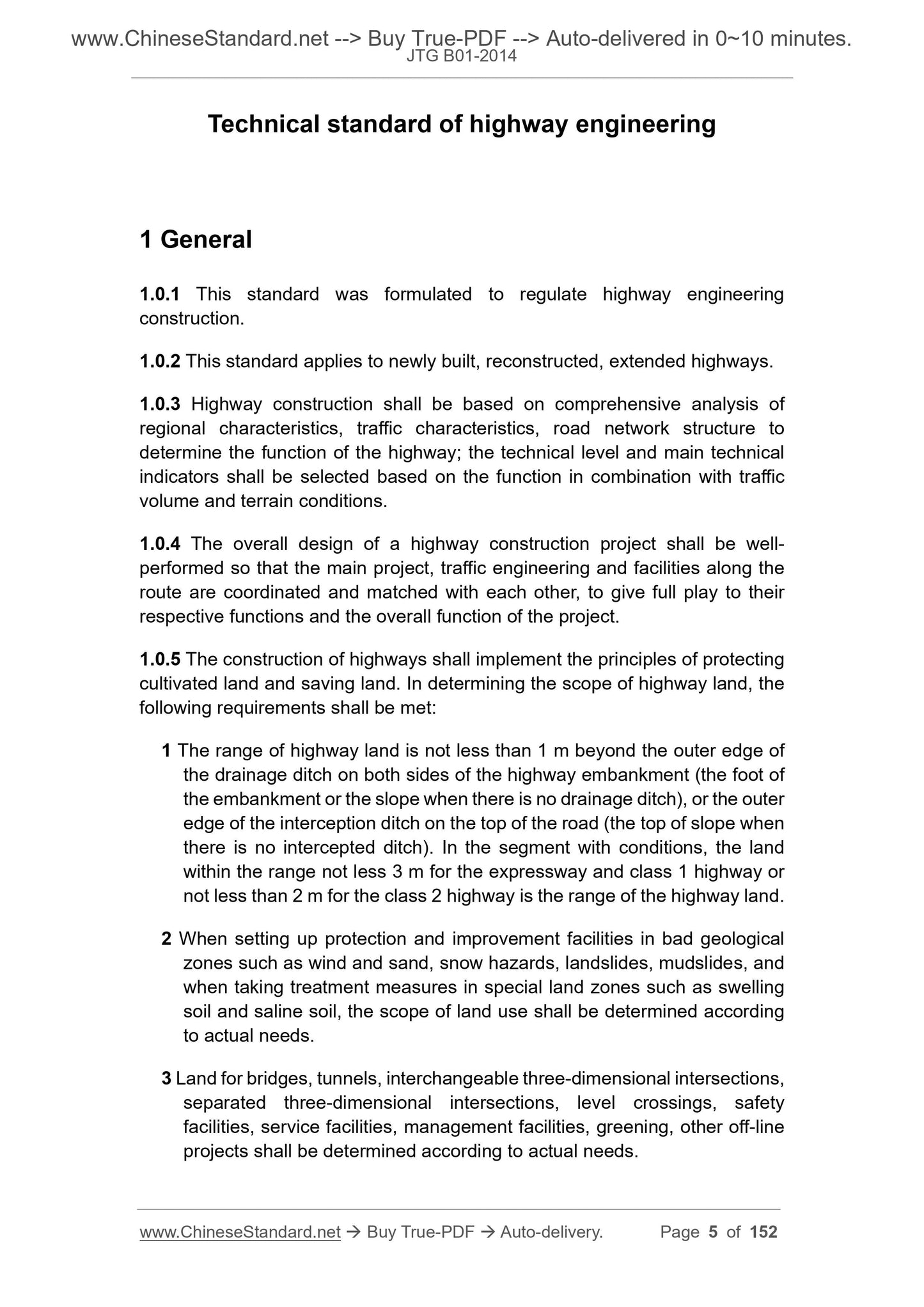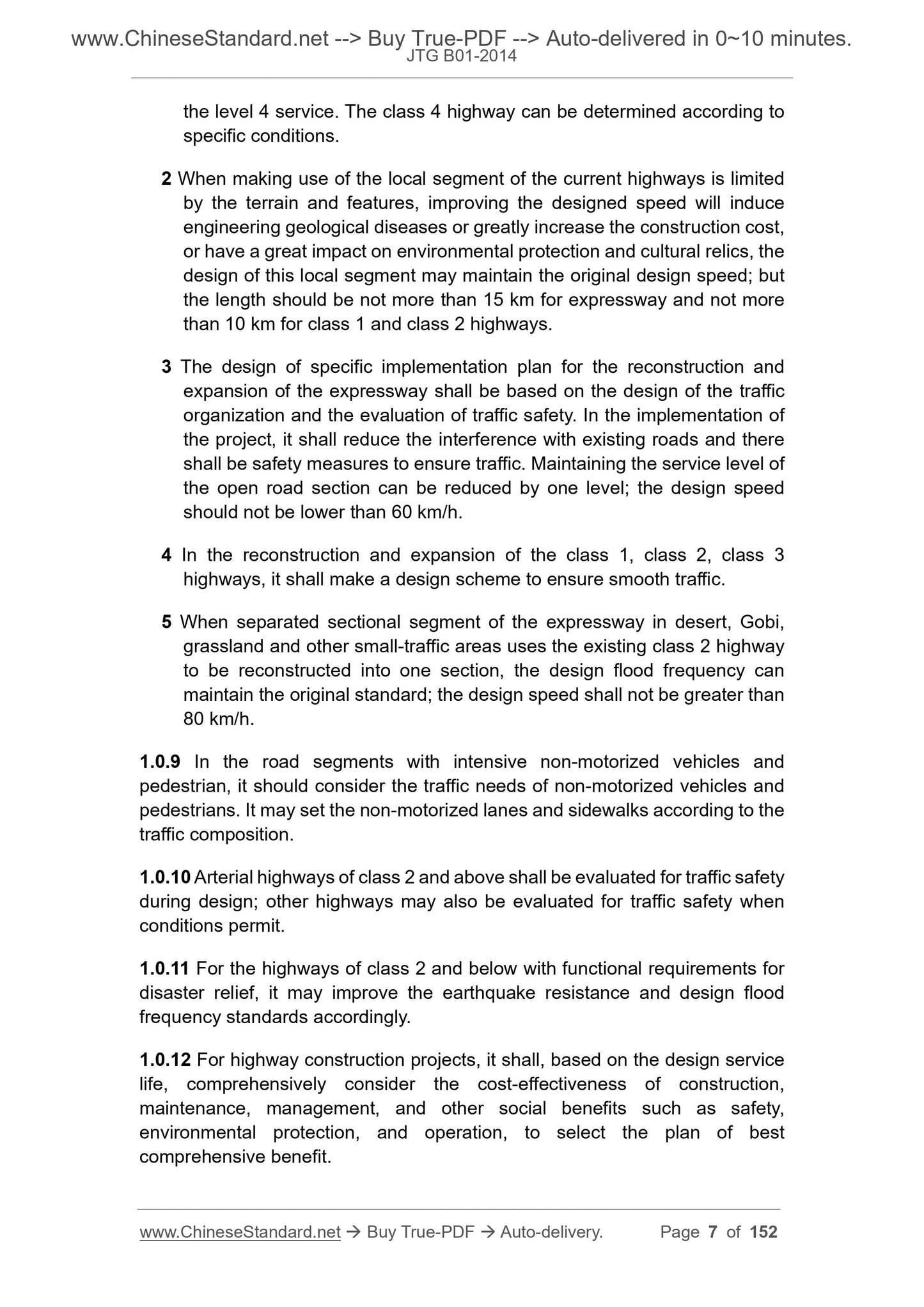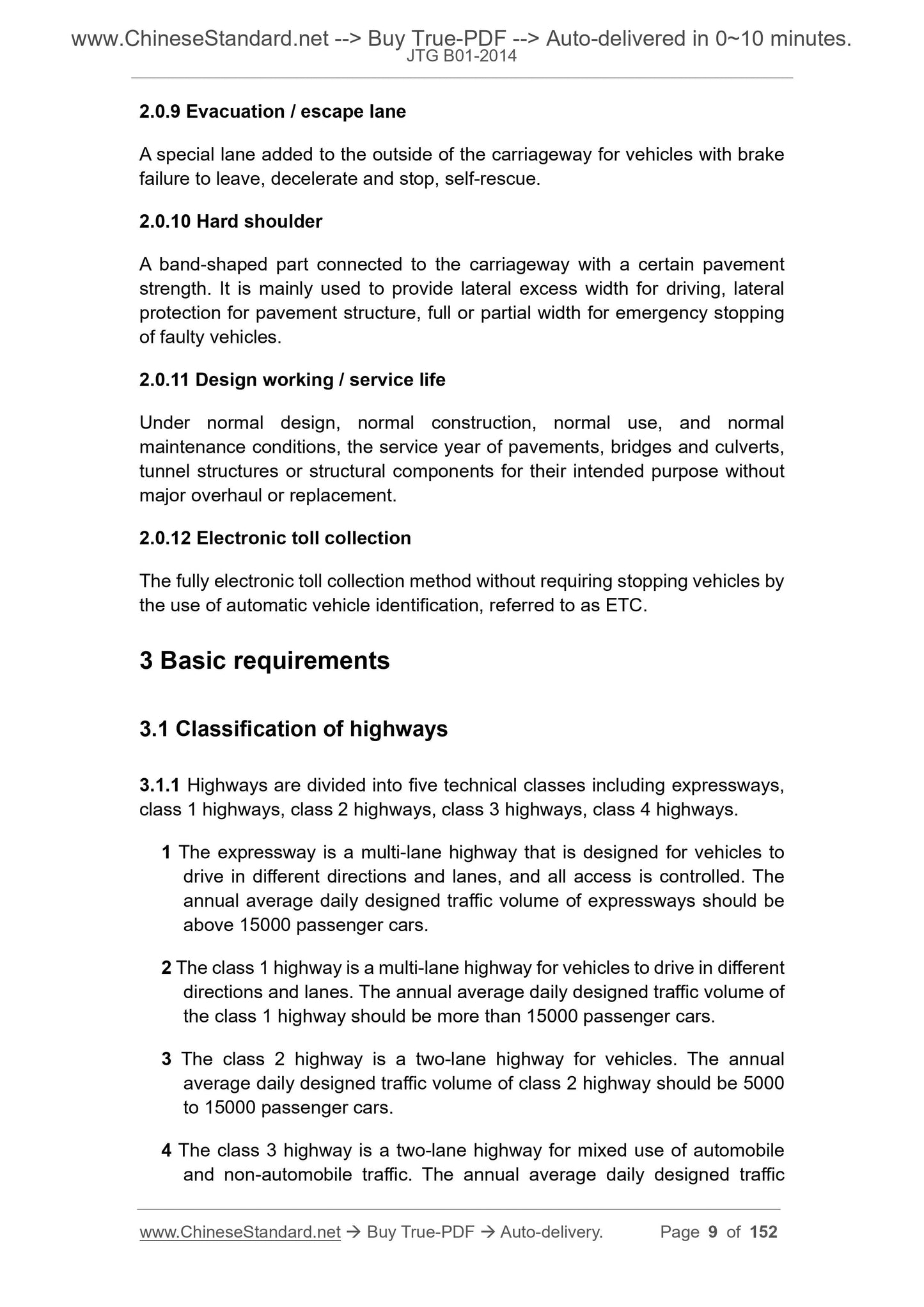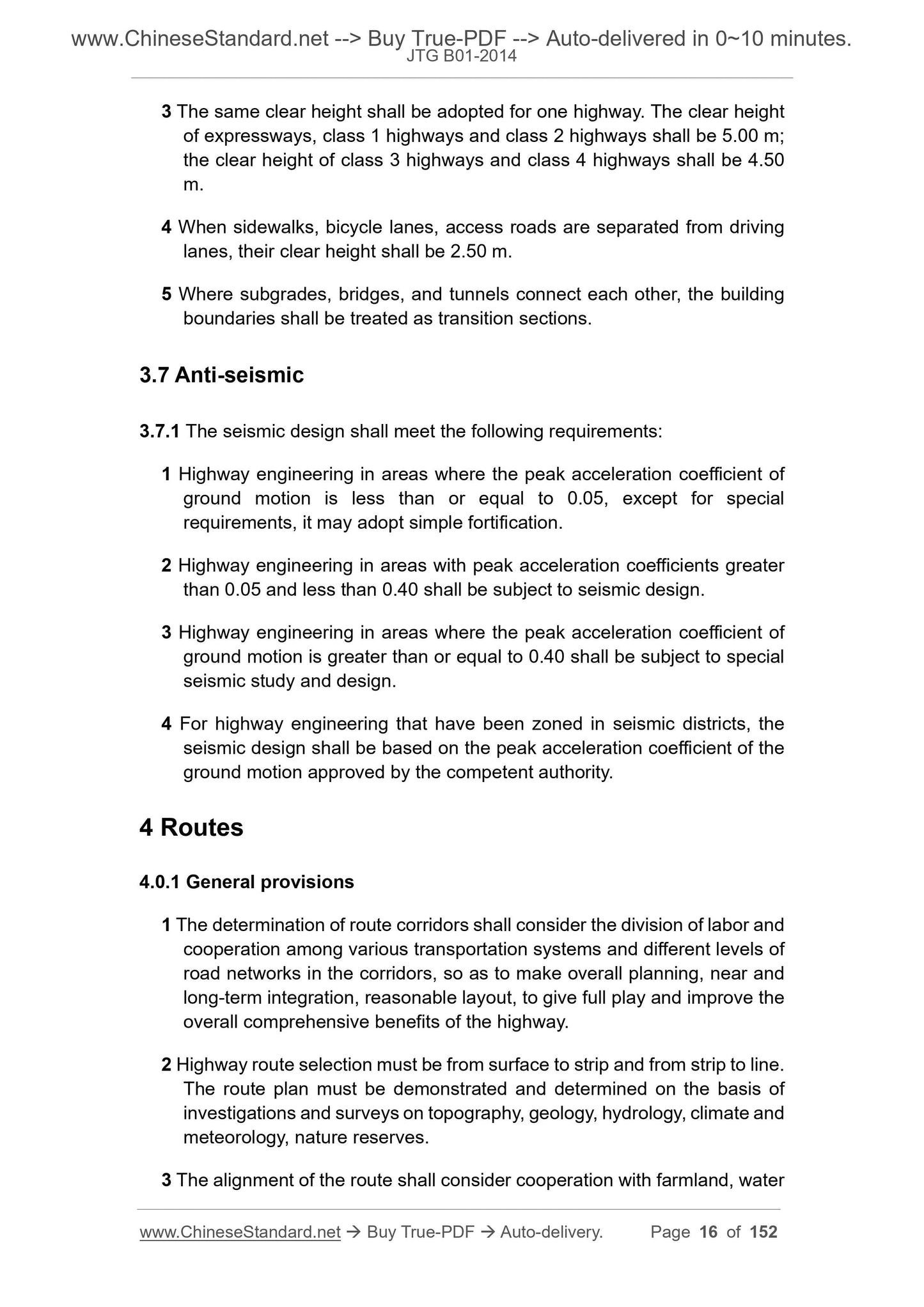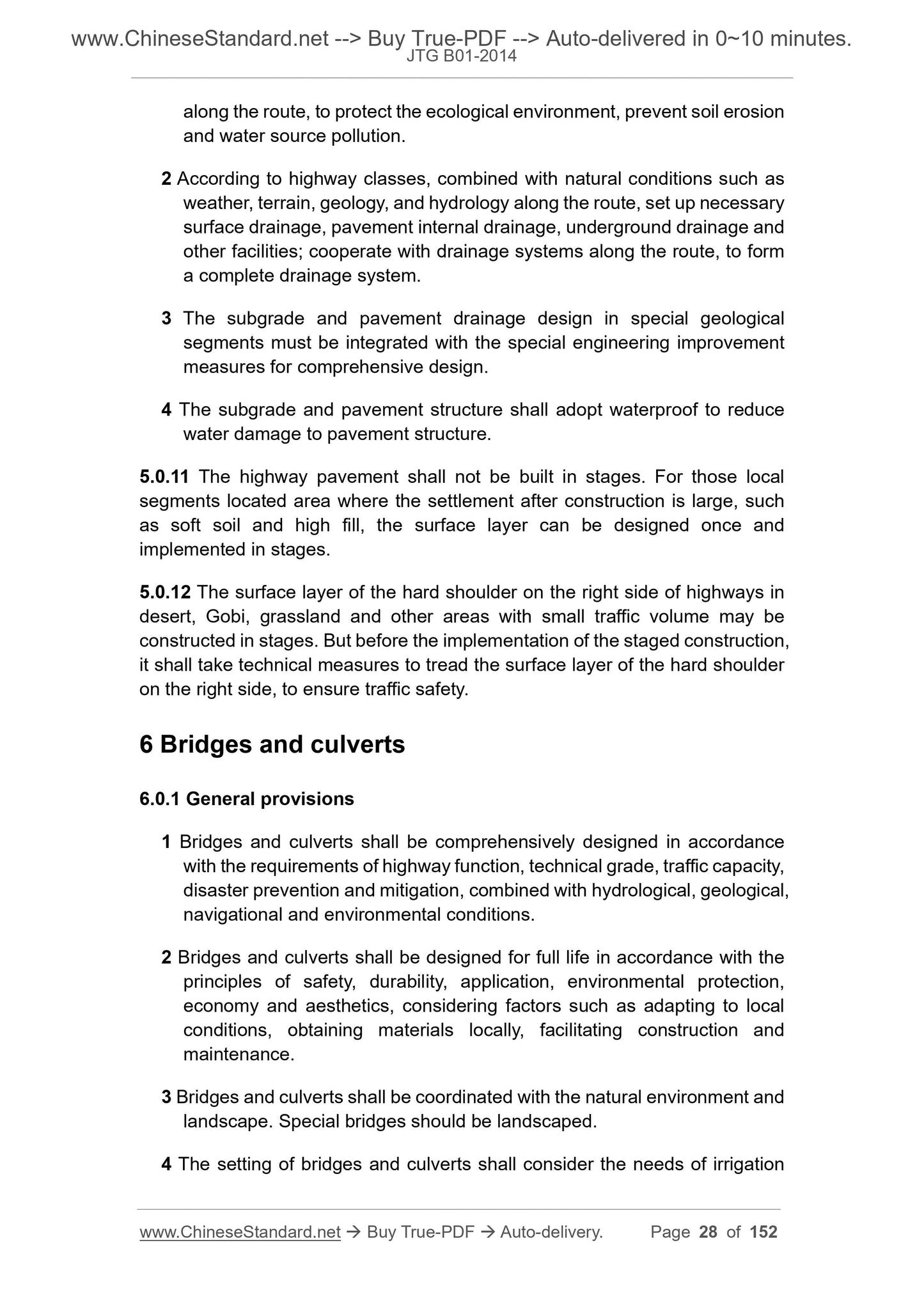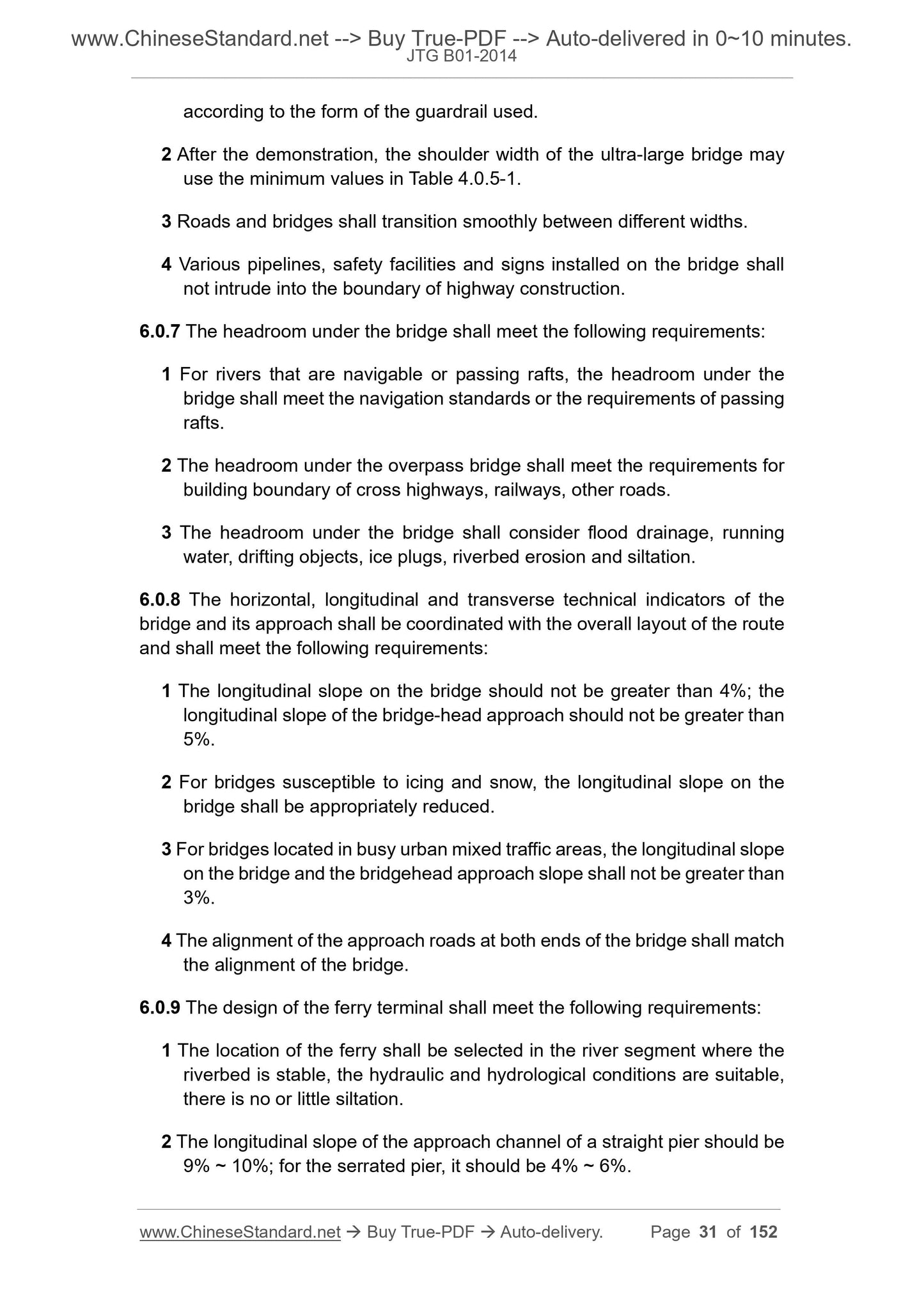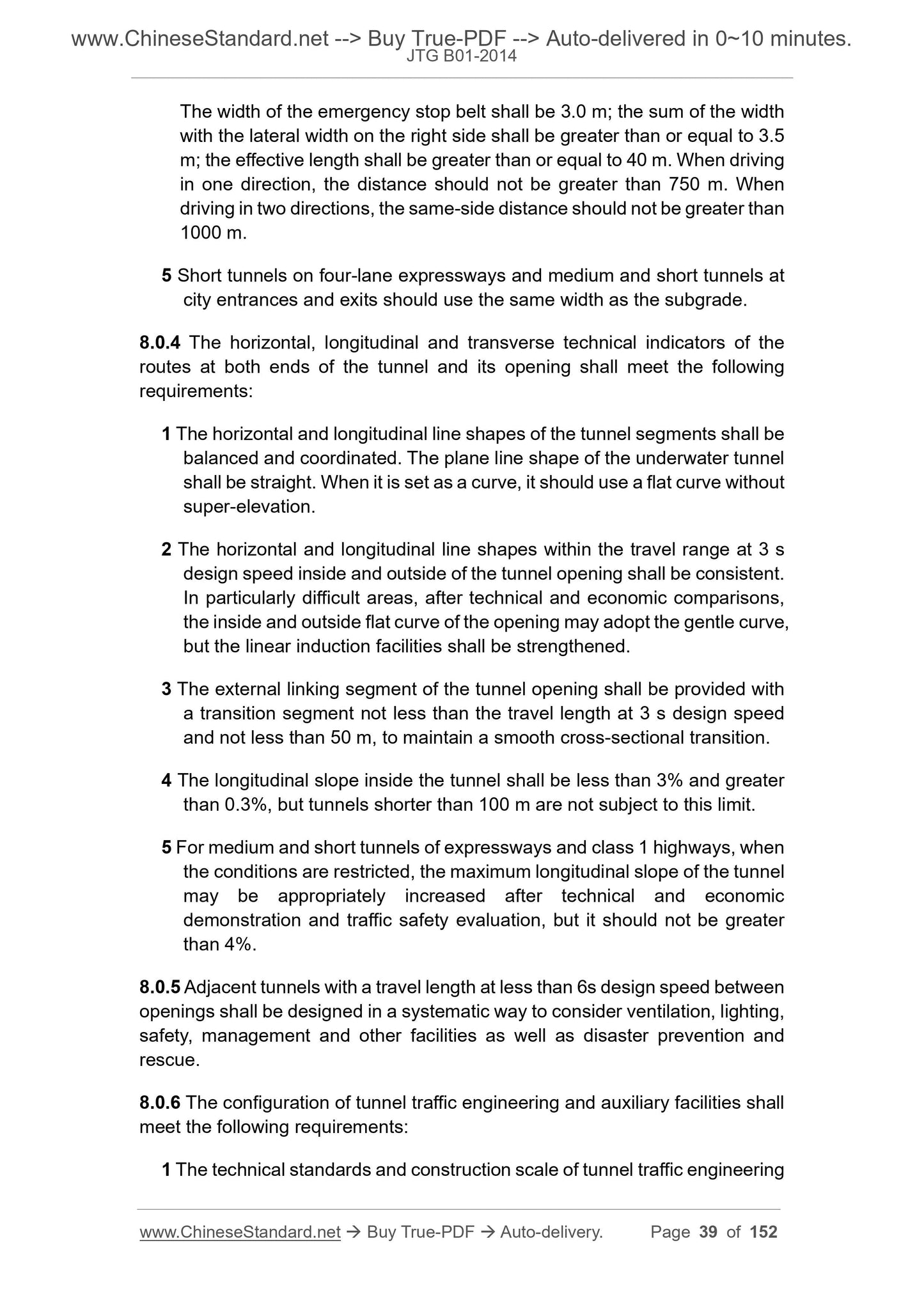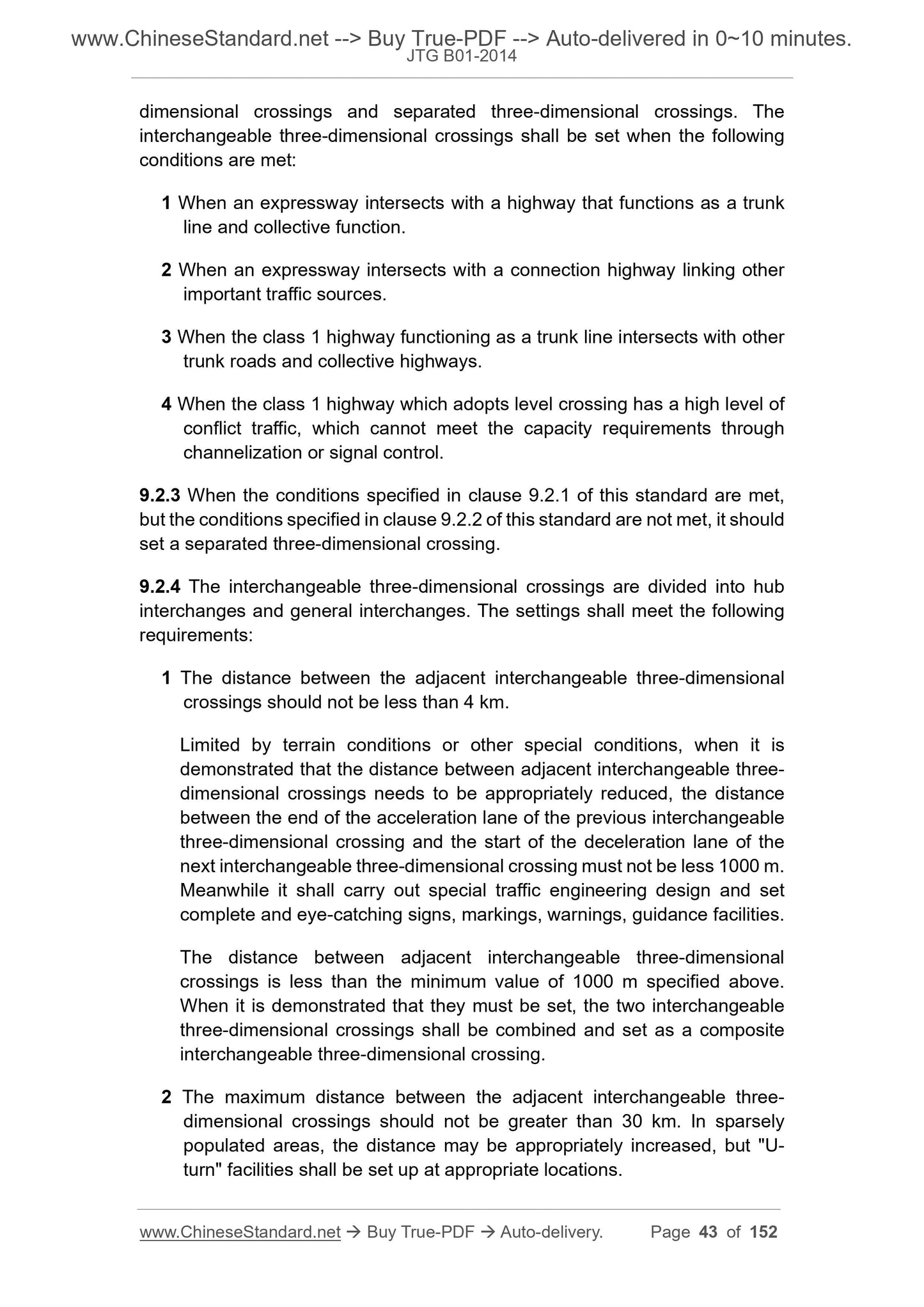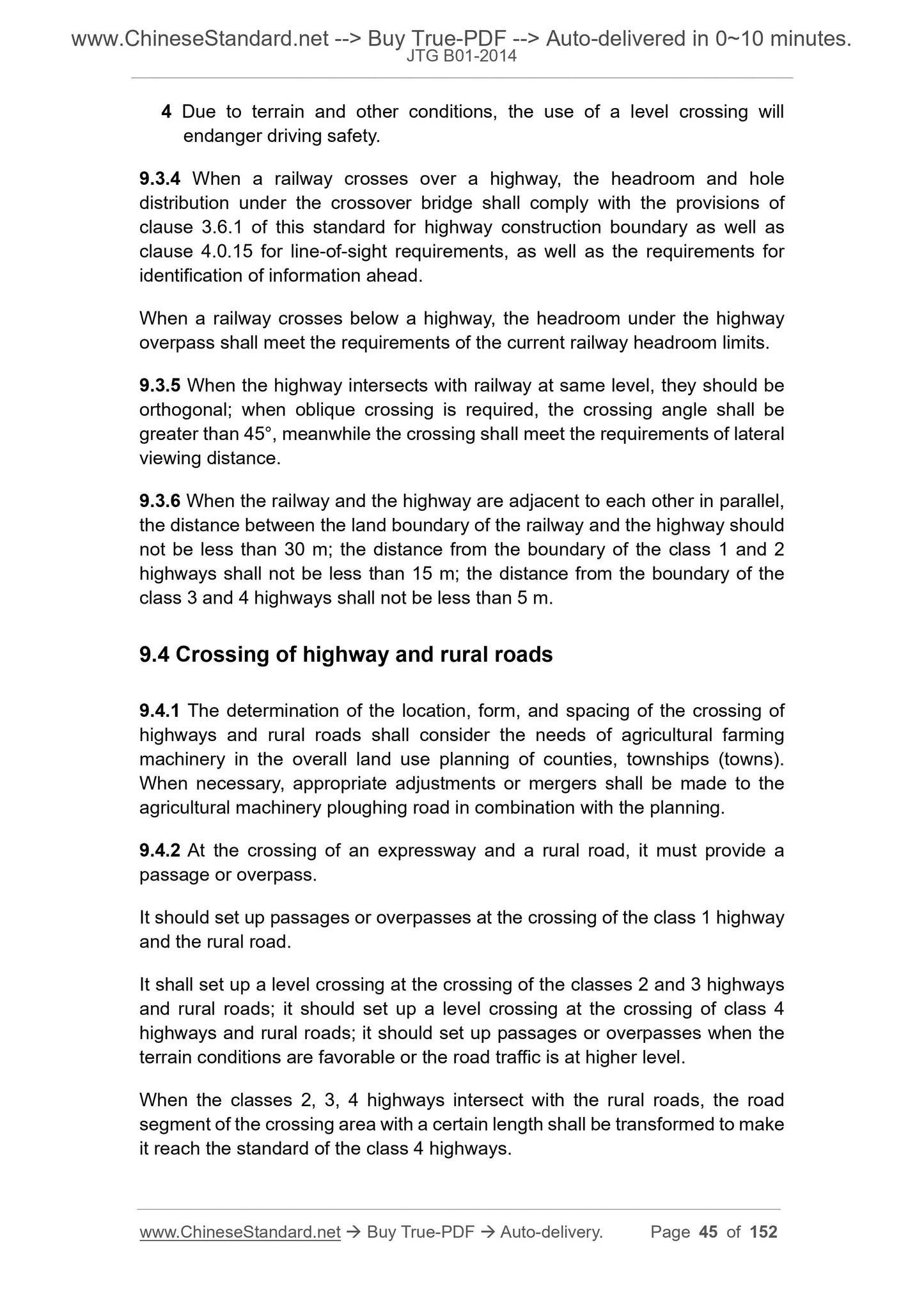1
/
of
12
PayPal, credit cards. Download editable-PDF and invoice in 1 second!
JTG B01-2014 English PDF
JTG B01-2014 English PDF
Regular price
$355.00 USD
Regular price
Sale price
$355.00 USD
Unit price
/
per
Shipping calculated at checkout.
Couldn't load pickup availability
Delivery: 3 seconds. Download true-PDF + Invoice.
Get QUOTATION in 1-minute: Click JTG B01-2014
Historical versions: JTG B01-2014
Preview True-PDF (Reload/Scroll if blank)
JTG B01-2014: Technical Standard of Highway Engineering
JTG B01-2014
INDUSTRIAL STANDARD OF THE
PEOPLE’S REPUBLIC OF CHINA
Technical standard of highway engineering
ISSUED ON: SEPTEMBER 30, 2014
IMPLEMENTED ON: JANUARY 01, 2015
Issued by: Ministry of Transport of People’s Republic of China
INDUSTRIAL STANDARD OF THE
PEOPLE’S REPUBLIC OF CHINA
Technical standard of highway engineering
Main drafting organization:
Highway Administration Bureau of Ministry of Transport of PRC
CCCC FIRST HIGHWAY CONSTRUCTION CO., LTD
Approved by:
Ministry of Transport of PRC
Date of implementation: January 01, 2015
China Communication Press Co., Ltd.
Chief drafters: Huo Ming, Li Chunfeng
Main participating drafters: Zhou Ronggui, Liao Zhaohua, Guo Tengfeng, Meng
Shutao, Zhang Jinquan, Yu Peiyu, Han Changling, Sun Fuling, Wang Meng,
Wang Jing
Table of Contents
1 General ... 5
2 Terms and definitions ... 8
3 Basic requirements ... 9
3.1 Classification of highways ... 9
3.2 Design vehicle ... 10
3.3 Traffic ... 11
3.4 Service level ... 12
3.5 Speed ... 12
3.6 Building boundaries ... 13
3.7 Anti-seismic ... 16
4 Routes ... 16
5 Subgrade pavement ... 24
6 Bridges and culverts ... 28
7 Vehicle and crowd loads ... 33
8 Tunnel ... 37
9 Route crossing ... 41
9.1 Level crossing of highway and highway ... 41
9.2 Three-dimensional crossing of highway and highway ... 42
9.3 Crossing of highway and railway ... 44
9.4 Crossing of highway and rural roads ... 45
9.5 Crossing of highway and pipeline ... 46
9.6 Animal passage ... 47
10 Traffic engineering and facilities along route ... 47
10.1 General provisions ... 47
10.2 Traffic safety facilities ... 48
10.3 Service facilities ... 50
10.4 Management facilities ... 51
Appendix A Classification of highway service levels ... 54
Appendix B Stopping sight distance and identifying sight distance of trucks . 57
Explanation of wording in this code ... 59
Explanation of Provisions ... 60
1 General ... 61
3 Basic requirements ... 66
4 Routes ... 79
5 Subgrade and pavement ... 100
6 Bridges and culverts ... 107
7 Vehicle and crowd loads ... 116
8 Tunnel ... 123
9 Route crossing ... 133
10 Traffic engineering and facilities along route ... 143
Technical standard of highway engineering
1 General
1.0.1 This standard was formulated to regulate highway engineering
construction.
1.0.2 This standard applies to newly built, reconstructed, extended highways.
1.0.3 Highway construction shall be based on comprehensive analysis of
regional characteristics, traffic characteristics, road network structure to
determine the function of the highway; the technical level and main technical
indicators shall be selected based on the function in combination with traffic
volume and terrain conditions.
1.0.4 The overall design of a highway construction project shall be well-
performed so that the main project, traffic engineering and facilities along the
route are coordinated and matched with each other, to give full play to their
respective functions and the overall function of the project.
1.0.5 The construction of highways shall implement the principles of protecting
cultivated land and saving land. In determining the scope of highway land, the
following requirements shall be met:
1 The range of highway land is not less than 1 m beyond the outer edge of
the drainage ditch on both sides of the highway embankment (the foot of
the embankment or the slope when there is no drainage ditch), or the outer
edge of the interception ditch on the top of the road (the top of slope when
there is no intercepted ditch). In the segment with conditions, the land
within the range not less 3 m for the expressway and class 1 highway or
not less than 2 m for the class 2 highway is the range of the highway land.
2 When setting up protection and improvement facilities in bad geological
zones such as wind and sand, snow hazards, landslides, mudslides, and
when taking treatment measures in special land zones such as swelling
soil and saline soil, the scope of land use shall be determined according
to actual needs.
3 Land for bridges, tunnels, interchangeable three-dimensional intersections,
separated three-dimensional intersections, level crossings, safety
facilities, service facilities, management facilities, greening, other off-line
projects shall be determined according to actual needs.
1.0.6 Highway construction must implement national laws and regulations on
environmental protection and resource conservation; meanwhile it shall meet
the following requirements:
1 Highway environmental protection shall implement the principle of
“protection first, prevention first, supplemented by governance,
comprehensive management”.
2 Highway construction shall be carried out according to natural conditions,
to carry out greening and beautify road capacity, protect the environment.
3 The construction of expressways, class 1 and class 2 highways and
highways with special requirements shall be subject to environmental
impact assessment and assessment of soil and water conservation
programs.
4 Eco-environmentally fragile areas, or areas where the environment may be
difficult to recover in the near future due to highway construction, shall be
designed for environmental protection.
5 Highway reconstruction and expansion projects shall make full use of
highway waste materials to save engineering construction resources.
1.0.7 The construction of highways in phases must be overall designed in
accordance with the principles of overall planning and implementation in
phases, and shall meet the following requirements:
1 The early-phase projects shall still be fully utilized in the later phases.
2 The integral section of the expressway shall not be constructed horizontally
in sections and stages.
3 Separated section segments of expressways may be constructed in
sections and stages. When the first section is opened to traffic according
to two-way traffic, it shall be managed in accordance with the traffic
conditions of the class 2 highway.
1.0.8 During the reconstruction and expansion of highways, demonstration and
comparison of reconstruction and expansion plans and new construction plans
shall be conducted. When adopting the reconstruction and expansion plan, the
following requirements shall be met:
1 The timing of highway reconstruction and expansion shall be determined
based on the actual service level through demonstration. The service
levels of expressways and class 1 highways should be lowered to be in
front of the lower limit of the level 3 service; the service levels of class 2
and class 3 highways should be lowered to be in front of the lower limit of
the level 4 service. The class 4 highway can be determined according to
specific conditions.
2 When making use of the local segment of the current highways is limited
by the terrain and features, improving the designed speed will induce
engineering geological diseases or greatly increase the construction cost,
or have a great impact on environmental protection and cultural relics, the
design of this local segment may maintain the original design speed; but
the length should be not more than 15 km for expressway and not more
than 10 km for class 1 and class 2 highways.
3 The design of specific implementation plan for the reconstruction and
expansion of the expressway shall be based on th...
Get QUOTATION in 1-minute: Click JTG B01-2014
Historical versions: JTG B01-2014
Preview True-PDF (Reload/Scroll if blank)
JTG B01-2014: Technical Standard of Highway Engineering
JTG B01-2014
INDUSTRIAL STANDARD OF THE
PEOPLE’S REPUBLIC OF CHINA
Technical standard of highway engineering
ISSUED ON: SEPTEMBER 30, 2014
IMPLEMENTED ON: JANUARY 01, 2015
Issued by: Ministry of Transport of People’s Republic of China
INDUSTRIAL STANDARD OF THE
PEOPLE’S REPUBLIC OF CHINA
Technical standard of highway engineering
Main drafting organization:
Highway Administration Bureau of Ministry of Transport of PRC
CCCC FIRST HIGHWAY CONSTRUCTION CO., LTD
Approved by:
Ministry of Transport of PRC
Date of implementation: January 01, 2015
China Communication Press Co., Ltd.
Chief drafters: Huo Ming, Li Chunfeng
Main participating drafters: Zhou Ronggui, Liao Zhaohua, Guo Tengfeng, Meng
Shutao, Zhang Jinquan, Yu Peiyu, Han Changling, Sun Fuling, Wang Meng,
Wang Jing
Table of Contents
1 General ... 5
2 Terms and definitions ... 8
3 Basic requirements ... 9
3.1 Classification of highways ... 9
3.2 Design vehicle ... 10
3.3 Traffic ... 11
3.4 Service level ... 12
3.5 Speed ... 12
3.6 Building boundaries ... 13
3.7 Anti-seismic ... 16
4 Routes ... 16
5 Subgrade pavement ... 24
6 Bridges and culverts ... 28
7 Vehicle and crowd loads ... 33
8 Tunnel ... 37
9 Route crossing ... 41
9.1 Level crossing of highway and highway ... 41
9.2 Three-dimensional crossing of highway and highway ... 42
9.3 Crossing of highway and railway ... 44
9.4 Crossing of highway and rural roads ... 45
9.5 Crossing of highway and pipeline ... 46
9.6 Animal passage ... 47
10 Traffic engineering and facilities along route ... 47
10.1 General provisions ... 47
10.2 Traffic safety facilities ... 48
10.3 Service facilities ... 50
10.4 Management facilities ... 51
Appendix A Classification of highway service levels ... 54
Appendix B Stopping sight distance and identifying sight distance of trucks . 57
Explanation of wording in this code ... 59
Explanation of Provisions ... 60
1 General ... 61
3 Basic requirements ... 66
4 Routes ... 79
5 Subgrade and pavement ... 100
6 Bridges and culverts ... 107
7 Vehicle and crowd loads ... 116
8 Tunnel ... 123
9 Route crossing ... 133
10 Traffic engineering and facilities along route ... 143
Technical standard of highway engineering
1 General
1.0.1 This standard was formulated to regulate highway engineering
construction.
1.0.2 This standard applies to newly built, reconstructed, extended highways.
1.0.3 Highway construction shall be based on comprehensive analysis of
regional characteristics, traffic characteristics, road network structure to
determine the function of the highway; the technical level and main technical
indicators shall be selected based on the function in combination with traffic
volume and terrain conditions.
1.0.4 The overall design of a highway construction project shall be well-
performed so that the main project, traffic engineering and facilities along the
route are coordinated and matched with each other, to give full play to their
respective functions and the overall function of the project.
1.0.5 The construction of highways shall implement the principles of protecting
cultivated land and saving land. In determining the scope of highway land, the
following requirements shall be met:
1 The range of highway land is not less than 1 m beyond the outer edge of
the drainage ditch on both sides of the highway embankment (the foot of
the embankment or the slope when there is no drainage ditch), or the outer
edge of the interception ditch on the top of the road (the top of slope when
there is no intercepted ditch). In the segment with conditions, the land
within the range not less 3 m for the expressway and class 1 highway or
not less than 2 m for the class 2 highway is the range of the highway land.
2 When setting up protection and improvement facilities in bad geological
zones such as wind and sand, snow hazards, landslides, mudslides, and
when taking treatment measures in special land zones such as swelling
soil and saline soil, the scope of land use shall be determined according
to actual needs.
3 Land for bridges, tunnels, interchangeable three-dimensional intersections,
separated three-dimensional intersections, level crossings, safety
facilities, service facilities, management facilities, greening, other off-line
projects shall be determined according to actual needs.
1.0.6 Highway construction must implement national laws and regulations on
environmental protection and resource conservation; meanwhile it shall meet
the following requirements:
1 Highway environmental protection shall implement the principle of
“protection first, prevention first, supplemented by governance,
comprehensive management”.
2 Highway construction shall be carried out according to natural conditions,
to carry out greening and beautify road capacity, protect the environment.
3 The construction of expressways, class 1 and class 2 highways and
highways with special requirements shall be subject to environmental
impact assessment and assessment of soil and water conservation
programs.
4 Eco-environmentally fragile areas, or areas where the environment may be
difficult to recover in the near future due to highway construction, shall be
designed for environmental protection.
5 Highway reconstruction and expansion projects shall make full use of
highway waste materials to save engineering construction resources.
1.0.7 The construction of highways in phases must be overall designed in
accordance with the principles of overall planning and implementation in
phases, and shall meet the following requirements:
1 The early-phase projects shall still be fully utilized in the later phases.
2 The integral section of the expressway shall not be constructed horizontally
in sections and stages.
3 Separated section segments of expressways may be constructed in
sections and stages. When the first section is opened to traffic according
to two-way traffic, it shall be managed in accordance with the traffic
conditions of the class 2 highway.
1.0.8 During the reconstruction and expansion of highways, demonstration and
comparison of reconstruction and expansion plans and new construction plans
shall be conducted. When adopting the reconstruction and expansion plan, the
following requirements shall be met:
1 The timing of highway reconstruction and expansion shall be determined
based on the actual service level through demonstration. The service
levels of expressways and class 1 highways should be lowered to be in
front of the lower limit of the level 3 service; the service levels of class 2
and class 3 highways should be lowered to be in front of the lower limit of
the level 4 service. The class 4 highway can be determined according to
specific conditions.
2 When making use of the local segment of the current highways is limited
by the terrain and features, improving the designed speed will induce
engineering geological diseases or greatly increase the construction cost,
or have a great impact on environmental protection and cultural relics, the
design of this local segment may maintain the original design speed; but
the length should be not more than 15 km for expressway and not more
than 10 km for class 1 and class 2 highways.
3 The design of specific implementation plan for the reconstruction and
expansion of the expressway shall be based on th...
Share
